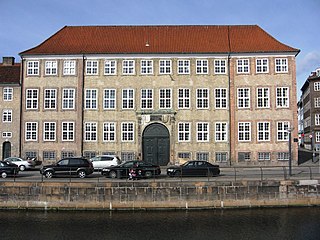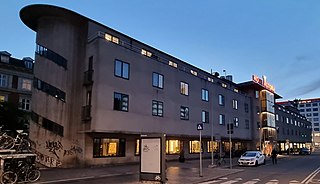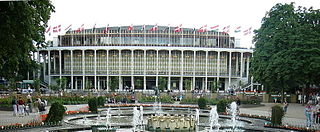
Tivoli Gardens, also known simply as Tivoli, is an amusement park and pleasure garden in Copenhagen, Denmark. The park opened on 15 August 1843 and is the third-oldest operating amusement park in the world, after Dyrehavsbakken in nearby Klampenborg, also in Denmark, and Wurstelprater in Vienna, Austria.
Higher education in Denmark is offered by a range of universities, university colleges, business academies and specialised institutions. The national higher education system is in accordance with the Bologna Process, with bachelor's degrees, master's degrees and doctoral degrees. The majority of higher education institutions are the responsibility of the Ministry of Higher Education and Science; however, some higher education institutions within the arts are the responsibility of the Ministry of Culture.

Christiansborg Palace is a palace and government building on the islet of Slotsholmen in central Copenhagen, Denmark. It is the seat of the Danish Parliament, the Danish Prime Minister's Office, and the Supreme Court of Denmark. Also, several parts of the palace are used by the Danish monarch, including the Royal Reception Rooms, the Palace Chapel and the Royal Stables.

The Radisson Collection Hotel, Royal Copenhagen is a historic hotel in Copenhagen, Denmark.

Kongens Nytorv is a public square in Copenhagen, Denmark, centrally located at the end of the pedestrian street Strøget. The largest square of the city, it was laid out by Christian V in 1670 in connection with a major extension of the fortified city, and has an equestrian statue of him at its centre. The initiative moved the centre of the city from the medieval area around Gammeltorv, at that time a muddy medieval marketplace, to a cobbled new square with a garden complex, inspired by the Royal city planning seen in Paris from the early 17th century.

Jens Vilhelm Dahlerup was a Danish architect who specialized in the Historicist style. One of the most productive and noted Danish architects of the 19th century, he is behind many of the most known buildings and landmarks of his time and has more than any other single architect contributed to the way Copenhagen appears today.

3XN is a Danish architectural practice headquartered in Copenhagen and with offices in Stockholm, London, New York and Sydney.

The Ministry of Culture Denmark is a ministry of the Danish Government, with responsibility for culture, sport and media.

Hans Christian Hansen was a Historicist Danish architect who worked 18 years in Greece where he was active in the transformation of Athens from a small town to the country's capital and an international metropolis. Later in his career he returned to Denmark, where he became a professor at the Royal Danish Academy of Fine Arts and designed buildings such as the Copenhagen Municipal Hospital and the Østervold Observatory. He was the brother of Theophilus Hansen who was also an internationally successful architect, active in Athens and Vienna. He is considered to be a pioneer in the study and application of polychrome architecture.
Kim Herforth Nielsen is a Danish architect, co-founder and principal of 3XN. He graduated from Aarhus School of Architecture in 1981 and has been a prominent figure in Danish and international architecture since then. Kim Herforth Nielsen has been at the forefront of a number of noteworthy projects, such as Ørestad College and Royal Arena in Copenhagen, the Danish Embassy in Berlin, International Olympic Committee's HQ in Lausanne and Sydney Fish Market.

Heinrich (Henry) Emil Charles Wenck was a Danish architect, known for the numerous railway stations he designed in his capacity of chief architect for the Danish State Railways from 1894 to 1921. During the years Wenck held the post, the railway network in Denmark experienced a strong expansion and he designed around 150 stations of which 15 are listed today. Among these are Copenhagen Central Station and the Øresund Railway stations which are examples of his National Romantic and Historicist styles. From 1903 he was a titular professor at the Royal Danish Academy of Fine Arts in Copenhagen.

Thorvald Jørgensen was a Danish architect, most known for his design of Christiansborg Palace, the seat of the Danish Parliament, after it had been destroyed in a fire. He has also designed a number of churches in Copenhagen. He was Royal Building Inspector from 1911 to 1938.

Vester Voldgade is a street in Copenhagen, Denmark which runs from Jarmers Plads to the waterfront between Frederiksholms Kanal and Langebro, passing the City Hall Square on the way.

Hotel Astoria is a design hotel located next to the Central Station in Copenhagen, Denmark. The building is an early example of Functionalist architecture in Denmark. The hotel consists of a long slender wing forming a barrier between the urban space in front of the main entrance to the Central Station, which partly opens to the underground rail lines, and Reventlowsgade, the street on the Vesterbro side of the station. An example of architecture parlante, the building is intended to resemble a steam locomotive, It was listed in the Danish registry of protected buildings and places in 2019.

The Royal Arena is a multi-use indoor arena in the Ørestad South area of Copenhagen, Denmark. The ground was broken for construction on 26 June 2013 and the arena opened in February 2017. It has a capacity of 13,000 for sporting events and up to 16,000 for concerts.

Tivoli Concert Hall is a 1,660-capacity concert hall at Tivoli Gardens in Copenhagen, Denmark. The building, which was designed by Frits Schlegel and Hans Hansen, was built between 1954 and 1956. The concert hall is used for classical music, Broadway musicals, and jazz musicians.

H. C. Andersens Boulevard is the most densely trafficked artery in central Copenhagen, Denmark. The 1.3 km long six-lane street passes City Hall Square on its way from Jarmers Plads, a junction just north of Vesterport station, to Lange Bridge which connects it to Amager Boulevard on Amager. From Jarmers Plads traffic continues along Gyldenløvesgade which on the far side of The Lakes splits into Aaboulevard and Rosenørns Allé. At the City Hall Square the boulevard meets Vesterbrogade, another very busy and importaint street. Major landmarks along the street include Copenhagen City Hall, Copenhagen Central Fire Station and the Ny Carlsberg Glyptotek.

Radiohuset is the former headquarters of national Danish broadcaster DR, located on Rosenørns Allé in Frederiksberg, Copenhagen. The building complex was inaugurated in 1945 to a Functionalist design by Vilhelm Lauritzen and later expanded in 1958 and 1972. Vacated by DR when DR Byen was inaugurated in 2006, the buildings now house the Royal Danish Academy of Music as well as the Museum of Music once it reopens. The complex also contains a concert hall. The building was listed in 1994.

Jacob Wilhelm Nordan was a Danish-born, Norwegian architect. During his career, he was one of the most prolific church architects in Norway.

Åboulevard is a street in central Copenhagen, Denmark. Together with H. C. Andersens Boulevard in the city centre and Borups Allé, it forms a major artery in and out of the city. The road is built over Ladegårds Å, a canal originally built to supply Copenhagen with water, which still runs in a pipe under it, feeding water into Peblinge Lake.


















